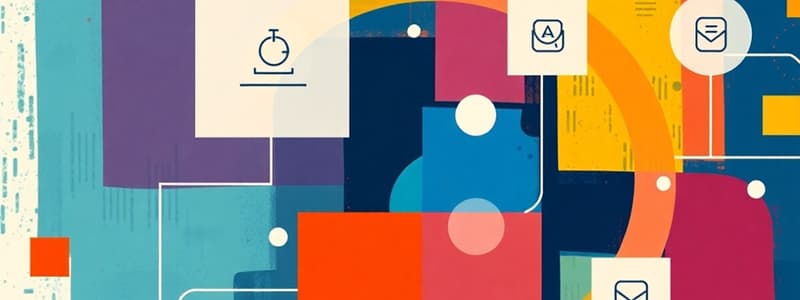Podcast
Questions and Answers
What is the main purpose of technology systems in architectural practices?
What is the main purpose of technology systems in architectural practices?
- To focus solely on visual aesthetics in design.
- To increase the speed and accuracy of business processes. (correct)
- To replace traditional drawing methods completely.
- To create complex architectural designs without any drafts.
What does the software development life cycle (SDLC) primarily help with?
What does the software development life cycle (SDLC) primarily help with?
- Conducting market research for architectural services.
- Creating marketing strategies for architectural firms.
- Establishing communication protocols among team members.
- Building and implementing technology systems within a firm. (correct)
Which of the following is a phase of the software development life cycle?
Which of the following is a phase of the software development life cycle?
- Plan (correct)
- Evaluate
- Manufacture
- Pilot
What is required before adopting a business process accelerator?
What is required before adopting a business process accelerator?
Which technology is mentioned as an example of a business process accelerator?
Which technology is mentioned as an example of a business process accelerator?
What is the main purpose of information gathering in the context of business processes?
What is the main purpose of information gathering in the context of business processes?
What is a potential issue when purchasing feature-rich software for a firm?
What is a potential issue when purchasing feature-rich software for a firm?
What is the outcome of identifying and categorizing the root causes of problems?
What is the outcome of identifying and categorizing the root causes of problems?
What does the 'must-have' categorization in technology system requirements entail?
What does the 'must-have' categorization in technology system requirements entail?
Which of the following is a recommended approach for gathering information effectively?
Which of the following is a recommended approach for gathering information effectively?
What is a significant risk of individual workstation file backup systems?
What is a significant risk of individual workstation file backup systems?
Which type of requirements relates specifically to user-driven functions?
Which type of requirements relates specifically to user-driven functions?
How can requirements in a business context be categorized?
How can requirements in a business context be categorized?
What best describes technical requirements?
What best describes technical requirements?
What would be an example of a nice-to-have requirement in a business?
What would be an example of a nice-to-have requirement in a business?
To meet client requirements in construction management, what must BIM software support?
To meet client requirements in construction management, what must BIM software support?
What is the primary focus of functional requirements?
What is the primary focus of functional requirements?
Why is a centralized backup system preferred over individual backup systems?
Why is a centralized backup system preferred over individual backup systems?
Which of the following aspects is usually associated with technical requirements?
Which of the following aspects is usually associated with technical requirements?
In a time-based design contract, what is a critical client requirement?
In a time-based design contract, what is a critical client requirement?
Flashcards are hidden until you start studying
Study Notes
Technology Systems in Architectural Practices
- Technology systems play a crucial role in modern architectural firms, accelerating processes like schematic design, design development, and contract document production.
- Implementing business process accelerators involves identifying needs, specifying requirements, and designing, building, and implementing the system.
- The Software Development Life Cycle (SDLC) methodology, commonly used in systems engineering and software development, can be applied to build technology systems within architectural firms.
Software Development Life Cycle (SDLC) Phases
- Plan: Identify unsatisfactory existing processes, determine the need for a technology solution, and establish goals for new or modified processes. A "digital-first" approach helps rethink traditional business models and embrace new opportunities.
- Information Gathering: Collect information about existing processes, proposed innovations, and requirements for improvement. Involve stakeholders responsible for executing processes to ensure accurate requirements.
- Analysis: Identify and categorize root causes of problems or challenges, develop solutions, and prioritize them.
Types of Technology System Requirements
- Must-have: Essential for core business functions, meeting client requirements, addressing operational deficiencies, or protecting critical systems. For example, centralizing backups to protect against data loss.
- Nice-to-have: Beneficial but not detrimental if unavailable. For example, exporting data from schedule and resource management software to the accounting system.
Categorization of Requirements
- Functional: Relate to software functionalities for users or the firm. For example, building information modeling (BIM) software must support client-required deliverables like models and data extracts.
- Technical: Relate to system requirements of hardware or operational needs of the business. For example, hardware and security measures must meet operational needs for speed and security.
Systems Integration
- Communication: Ensure integration of project information with CRM systems.
- Centralized Authentication Systems: Promote secure access and streamline user management.
Technology Systems for Business Operations
- Accounting/Finance: Utilize accounting software, financial reporting tools, and integrated payment systems.
- Communication: Employ phone, email, and instant messaging platforms for effective and efficient communication.
- Human Resources Management (HRM) Software: Track employees' and contractors' time and costs for accounting and financial purposes. Consider features such as timesheets, employee information, hiring process tools, performance reviews, and exit interviews.
- CRM – Sales and Contract Administration: Utilize CRM software to manage sales-related activities. Consider features such as centralized client contacts, lead tracking, project tracking, estimated revenue calculation, and reporting on the sales pipeline.
Support and Backup
- Develop a business continuity plan to address potential risk events such as floods, fires, and break-ins.
- Securely back up valuable data and information to ensure business continuity and mitigate the risk of permanent data loss.
Studying That Suits You
Use AI to generate personalized quizzes and flashcards to suit your learning preferences.




